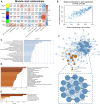Identification of Immune-Related Hub Genes in Thymoma: Defects in CD247 and Characteristics of Paraneoplastic Syndrome
- PMID: 35774508
- PMCID: PMC9237438
- DOI: 10.3389/fgene.2022.895587
Identification of Immune-Related Hub Genes in Thymoma: Defects in CD247 and Characteristics of Paraneoplastic Syndrome
Abstract
Background: Thymomas (Ts) and thymic carcinomas (TCs) are rare primary tumors of the mediastinum. Paraneoplastic syndrome (PNS) is an important feature of thymoma, which presents great challenges to clinicians. Methods: The present study uses the weighted gene co-expression network analysis (WGCNA) to identify possible immunologic mechanisms of thymoma. RNA sequencing data from thymoma samples were downloaded from the TCGA. Core genes were taken from the module that is closely related to the WHO's stage of classification. Enhanced analysis using the online database "Metascape" and an overall survival (OS) analysis were carried out via the Kaplan-Meier method. The hub genes were obtained from the protein-protein interaction (PPI) network. In addition, we jointly analyzed multiple sets of PNS data related to thymomas from other sources to verify the correlation between thymomas and PNS. The impact of hub genes on the prognosis of PNS was evaluated via the ROC curve, with simultaneous analysis of immune infiltration by CIBERSORT. Findings: The 14 immune hub genes closely related to thymomas were found to be jointly involved in the T-cell receptor signaling pathway. Compared to the normal thymus and type B1/B2 thymoma, there is a lower number of T-cells in type A/B3 thymoma and thymic carcinoma. The expression of genes related to the T-cell receptor signaling pathway appeared defective. The low expression of CD247 and the decrease in the number of mature T-cells are common features among thymomas, specific pulmonary fibrosis, rheumatoid arthritis, and systemic lupus erythematosus.
Keywords: CD247; Thymomas; WGCNA; immune; paraneoplastic syndrome (PNS).
Copyright © 2022 Deng.
Conflict of interest statement
The author declares that the research was conducted in the absence of any commercial or financial relationships that could be construed as a potential conflict of interest.
Figures







Similar articles
-
Thymoma-Related Paraneoplastic Syndrome Mimicking Reactive Arthritis.Medicina (Kaunas). 2021 Sep 4;57(9):932. doi: 10.3390/medicina57090932. Medicina (Kaunas). 2021. PMID: 34577855 Free PMC article.
-
Autoimmune disorders and paraneoplastic syndromes in thymoma.J Thorac Dis. 2020 Dec;12(12):7571-7590. doi: 10.21037/jtd-2019-thym-10. J Thorac Dis. 2020. PMID: 33447448 Free PMC article. Review.
-
Two types of immune infiltrating cells and six hub genes can predict the occurrence of myasthenia gravis in patients with thymoma.Bioengineered. 2021 Dec;12(1):5004-5016. doi: 10.1080/21655979.2021.1958634. Bioengineered. 2021. PMID: 34620045 Free PMC article.
-
Vascular architecture as a diagnostic marker for differentiation of World Health Organization thymoma subtypes and thymic carcinoma.Histopathology. 2017 Apr;70(5):693-703. doi: 10.1111/his.13114. Epub 2017 Jan 18. Histopathology. 2017. PMID: 27791295
-
Pathological aspects of malignant and benign thymic disorders.Ann Med. 1999 Oct;31 Suppl 2:5-14. Ann Med. 1999. PMID: 10574149 Review.
Cited by
-
Identification of qualitative characteristics of immunosuppression in sepsis based on immune-related genes and immune infiltration features.Heliyon. 2024 Apr 3;10(8):e29007. doi: 10.1016/j.heliyon.2024.e29007. eCollection 2024 Apr 30. Heliyon. 2024. PMID: 38628767 Free PMC article.
References
LinkOut - more resources
Full Text Sources

